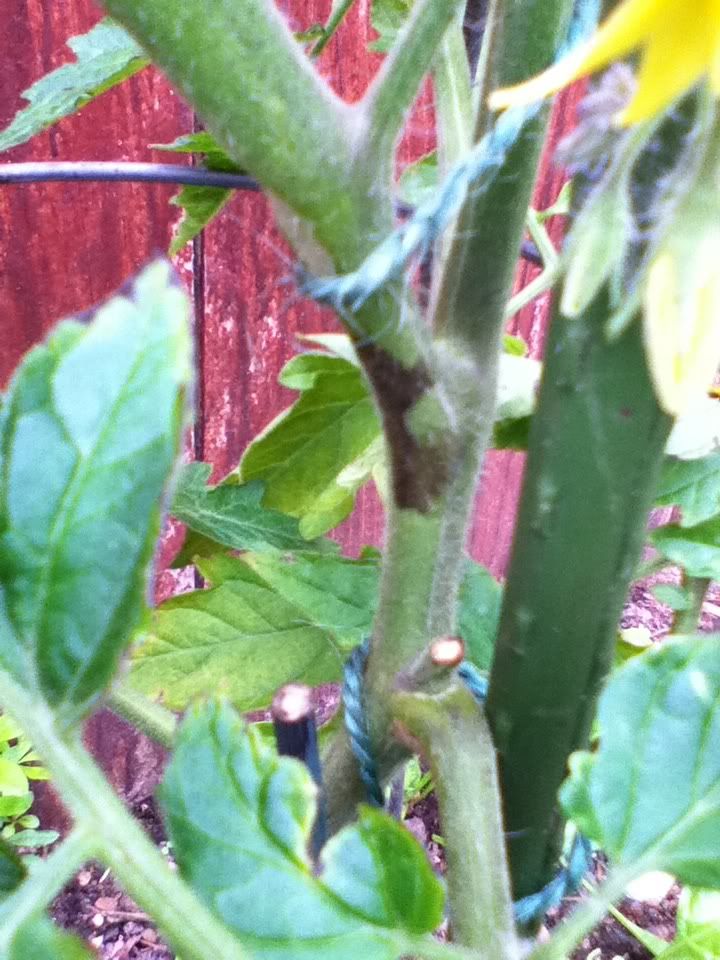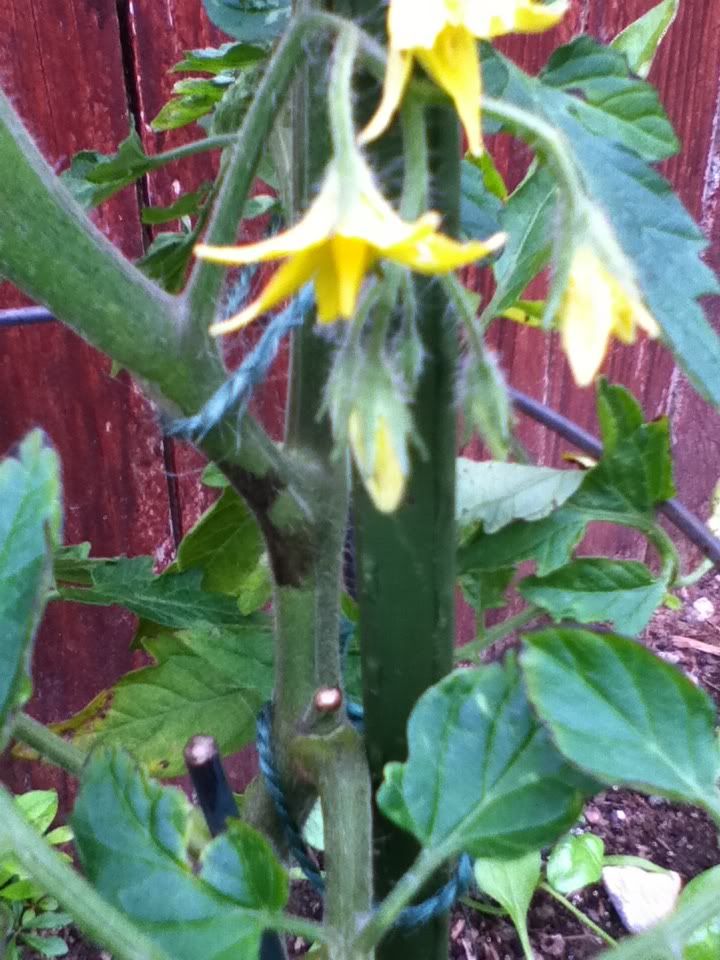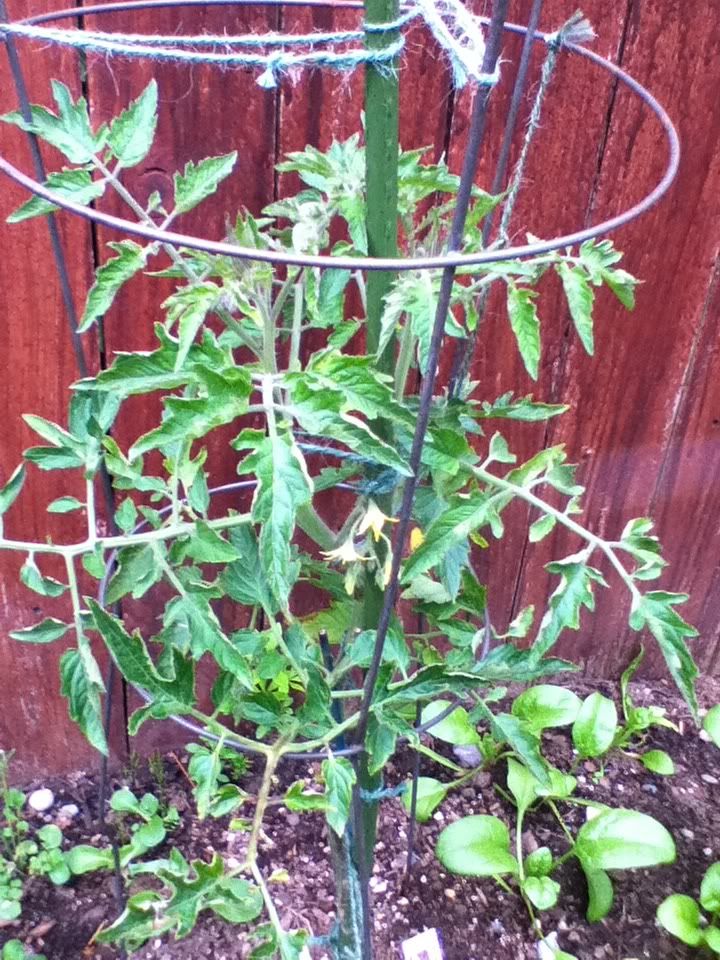

|
Information and discussion regarding garden diseases, insects and other unwelcome critters.
|
 |
|
|
Thread Tools | Display Modes |
|
|
#1 |
|
Tomatovillian™
Join Date: Jan 2011
Location: Pacific North West, zone 8a
Posts: 510
|
I really hope this is not late blight. It's on my healthy yellow pear plant, and no other plant has these stem lesions. There are only dark brown patches on it's central stem. Oh no, should I pull the plant so it doesn't spread? I thought late blight was supposed to be late! What is this?
  And here is a picture of the whole plant- its super healthy!!!  I got late blight last year, and this is what the stem lesions looked like exactly. But.... it's only June! Last year my plants died in late August.  I'm really worried. (Also, this is in a different tomato patch then I planted in last year. The tomatoes planted in the same patch seem fine.) I'm really worried. (Also, this is in a different tomato patch then I planted in last year. The tomatoes planted in the same patch seem fine.)Taryn 
|
|
|

|
|
|
#2 | |
|
Moderator Emeritus
Join Date: Jan 2006
Location: Upstate NY, zone 4b/5a
Posts: 21,169
|
Quote:
If you had LB documented last year then there's a good chance that might be it again b/c it is common in the state of WA as you know. It doesn''t matter if it's a different area where you're growing since the spores are spread by wind and rain and the disease is not soilborne. Earl Blight ( A. solani) can be found either early OR late in the season and the same is true for LB. I don't know where you live in WA but just wanted to note that LB has to have living tissue to overwinter so if all your plants from last year that were infected were removed and disposed of properly this probably means a new infeiction. What I don''t understand is that it's only on the YEllow PEar plant. Do you see any spots at all on the foliage of that plant or any other plant? And I ask b'c if so Early Blight can also have stem lesions but usually it's the foliage that has the spots first. And if it were a new infection I would expect not just ONE plant to be affected. Did you raise that plant from seed or did you buy it?
__________________
Carolyn |
|
|
|

|
|
|
#3 |
|
Tomatovillian™
Join Date: Jan 2011
Location: Pacific North West, zone 8a
Posts: 510
|
I bought it. Another thing that might be going on with this plant is that when I brought it home, a slice was cut off the stem going up and down. It's scabbed over now, and there are more lesions around the wounded area. Is this why? Should I take this plant out immediatly? Yikes!
 I've thoroughly searched my plants- this is the only one with any spots, and it only has about three and they are on the stem. Two are on the wounded area, and one is the one pictured. I've thoroughly searched my plants- this is the only one with any spots, and it only has about three and they are on the stem. Two are on the wounded area, and one is the one pictured.Taryn |
|
|

|
|
|
#4 | |
|
Moderator Emeritus
Join Date: Jan 2006
Location: Upstate NY, zone 4b/5a
Posts: 21,169
|
Quote:
If it were me I'd pull it ASAP and dispose of it correctly in a plastic bag for trash pickup. If it were me I'd also carefully scoop off the top layer of soil where the plant was and dispose of that as well, just in case there was any new sporulation that went on, which is remote but possible, and some spores had dropped to the soil.
__________________
Carolyn |
|
|
|

|
|
|
#5 |
|
Tomatovillian™
Join Date: Jan 2011
Location: Pacific North West, zone 8a
Posts: 510
|
Alright, I'll go do that now.
 I hope it doesn't spread!!! I hope it doesn't spread!!!
|
|
|

|
|
|
#6 |
|
Tomatovillian™
Join Date: Jan 2006
Location: NY z5
Posts: 1,205
|
Looks like LB to me too and it does sound like the seller tried to clean up the stem. I have had some success picking off spotty leaves and even spotty smaller stems to keep a large plant going long enough for green fruit to ripen, but if the main stem is infected the plant has to go.
To help keep the LB from spreading, I would also start ASAP a regular weekly preventative spray of Daconil, aka Ortho Garden Disease Control, Bonide Fung-onil, or whatever brand contains the active ingredient chlorothalonil. I get the pint bottle of concentrate and dilute it myself in my own sprayer. I find this easier and more economical than trying to use the thick, gloppy pre-mixed solution that comes in its own spray bottle. Also continue inspecting your other plants for new spots and get rid of any spotty leaf or small stem pronto. Try to avoid getting the foliage wet when watering the plants and also avoid handling healthy foliage while removing infected parts so you don't spread LB yourself. |
|
|

|
|
|
#7 |
|
Tomatovillian™
Join Date: Feb 2006
Location: Germany 49°26"N 07°36"E
Posts: 5,041
|
If you catch the disese in the early stages sometimes you can control it by spraying your plants with a mixture of EXEL LG and Actinovate. The Actinovate will deal with the spores as well as the Exel LG but the EXEL LG is a systemic and will deal with the bad guys on the inside of the plant as well. I had a few plants come up with lesions in the past and the above products kept it in check and was able to get a harvest from the plant. Both products are bio-friendly.
Set up a weekly spraying schedule with the above as a preventative as well. Ami
__________________
Life's journey is not to arrive at the grave safely in a well preserved body, but rather to skid in sideways, totally worn out, shouting ‘...Holy Crap .....What a ride!' |
|
|

|
|
|
#8 |
|
Tomatovillian™
Join Date: Jan 2007
Location: PNW
Posts: 4,743
|
Hey, it is only yellow pear. Do not feel too bad, it is as bland as any
tomato that I ever grew. It is far more important to protect your other plants from Late Blight.
__________________
-- alias |
|
|

|
|
|
#9 |
|
Tomatovillian™
Join Date: Oct 2010
Location: Cincinnati
Posts: 907
|
Are the pictures above definitely blight? I just noticed the same stem lesions on my Couilles de Taureau plant. It is the only plant with the lesions, and the foliage looks fine. I have been spraying with Ortho Max Disease Control, but I was unable to spray this week because it rained yesterday and looks like it will rain tomorrow (and possibly through the weekend).
I have had problems with early blight, but never late blight, and the early blight was always on the foliage. This is a first for me as far as stem lesions. Should I also pull this plant and dispose of it? 
|
|
|

|
|
|
#10 |
|
Tomatovillian™
Join Date: Jun 2010
Location: Central VA
Posts: 436
|
I would like to know the answer to this as well!!!
|
|
|

|
|
|
#11 |
|
Moderator Emeritus
Join Date: Jan 2006
Location: Upstate NY, zone 4b/5a
Posts: 21,169
|
Both Late Blight ( LB ) and Early Blight (EB) have very characteristic leaf lesions, most of the time. I saw no leaf lesions on that Yellow Pear at all, but given that the area had LB last year, I think caution was needed.
Yes, EB can also cause dark colored stem lesions as well. If near the soil level it's called Collar Rot and my tomato disease book goes thru all the other areas of a plant where EB can infect, such as the fruits themselves as well as the petioles, etc. At the top of this Disease Forum there's a problem Solver and within that link I know there's one to TAMU but I don't know if the other good one from Cornell is there so I'll just link to it here: http://vegetablemdonline.ppath.corne...omWiltKey.html Dr Zitter at Cornell and Dr. Gardner, formerly of NCSU are the two main experts with EB.
__________________
Carolyn |
|
|

|
|
|
#12 |
|
Tomatovillian™
Join Date: Jan 2006
Location: Anmore, BC, Canada
Posts: 3,970
|
It looks like late blight to me. Last year here in PNW I saw many tomato plants that were showing the LB symptoms starting with stems, but then it got quickly spread around.
This is very disturbing when a commercial vendor sells infected plants. Last year was bad enough for us, PNWers, I hope we will not have another year like that!
__________________
 Tatiana's TOMATObase Tatiana's TOMATObase
|
|
|

|
|
|
#13 | |
|
Tomatovillian™
Join Date: Oct 2010
Location: Cincinnati
Posts: 907
|
Quote:
If it is blight, I guess the safe thing to do is pull the plant so it doesn't spread to my other plants. Since that was your recommendation to Taryn, would that also be your recommendation to me? Oh, I hate to go out and pull that plant. |
|
|
|

|
|
|
#14 | |
|
Moderator Emeritus
Join Date: Jan 2006
Location: Upstate NY, zone 4b/5a
Posts: 21,169
|
Quote:
In all the eyars of growing tomatoes it's only a few times that I've seen stem lesions on EB infected plants and I honestly can't remember if there were leaf lesions as well. Stem lesions don't always look like the pictures at a disease site appear, so I don't think that's a strong consideration. And the fact that you have just ONE plant with these lesions is a bit strange to me since both LB and EB are spread by wind and rain and usually infect many more than one plant amongst others. If it were me I think I'd check all other plants first, then if nothing, blast those lesions with Daconil, your Ortho product, and watch it closely. Best I can do but the final decision, as always, rests with you. I can tell you that Couilles de Taureau is a really nice variety, but that shouldn't sway your decision b'c there's always next year.  Again, Taryn knows that LB has been in her garden and you say that it hasn't been in yours, and to me that's a strong point to consider especially with only one plant affected, to date.
__________________
Carolyn |
|
|
|

|
|
|
#15 |
|
Tomatovillian™
Join Date: Jun 2010
Location: England
Posts: 512
|
Also, think about the weather conditions; late blight needs humid conditions to spread. If the forecast is for dry weather you might have time to sit back and observe the problem before deciding on a course of action. If the forecast is wet then better not to take the chance, just pull the plant.
|
|
|

|
 |
|
|
